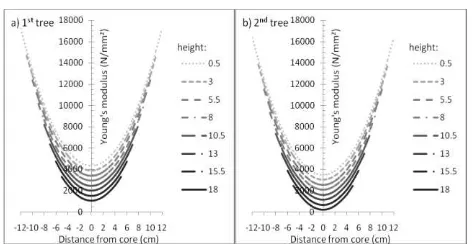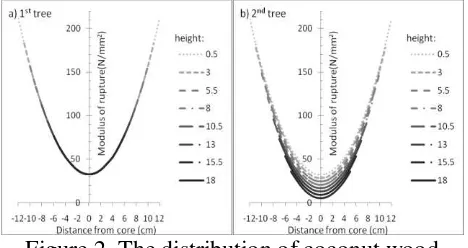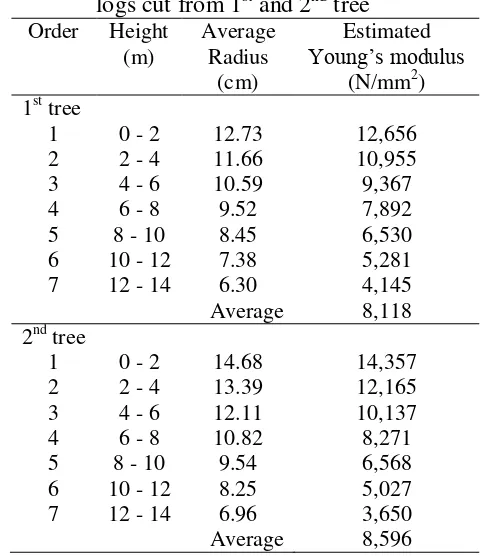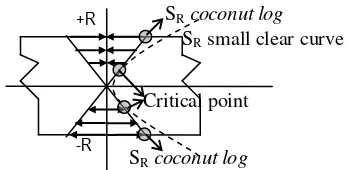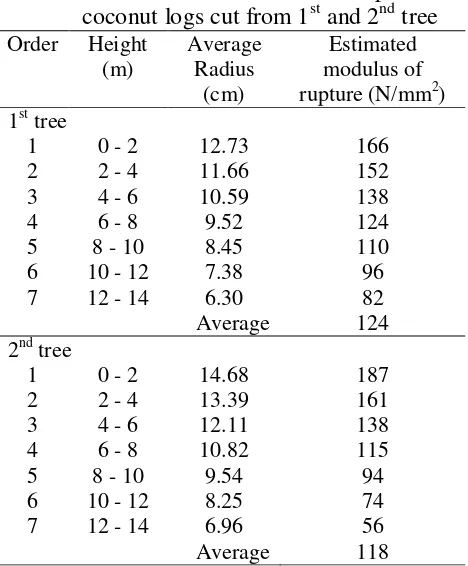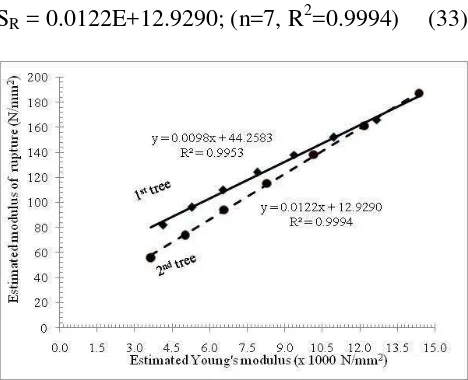Estimating
Young’s Modul
us and Modulus of Rupture of Coconut Logs by Small
Clear Specimen Flexure Testing
Effendi Tri Bahtiar1, Naresworo Nugroho1, Surjono Surjokusumo2 1
Forest Products Department, Bogor Agricultural University, Bogor 16680. Indonesia 2
Civil Engineering Department, Pakuan University, Bogor 16001. Indonesia
Abstract
Mechanical properties of coconut logs must be available to make a good building design using the material. The properties should be measured by full scale testing, which is almost impossible in Indonesia today because it costs expensive and needs high power equipments. This research develops a theory to estimate Young’s modulus (E) and modulus of rupture (SR) of coconut-logs by reconstruction methods. The flexural testing is conducted to small clear specimen. Coconut-logs are reconstructed by replacing each small clear specimen on its natural place theoretically, and then the properties are estimated by mechanics, statistics, calculus and geometric analytic equation. This method is successful estimating Young’s modulus and modulus of rupture of coconut logs based on small clear specimen flexural testing. The average estimated Young’s modulus value of coconut logs cut from 1st and 2nd tree, are 8,118 N/mm2 and 8,596 N/mm2. The average modulus of rupture is 124 N/mm2 and 118 N/mm2 respectively. The two properties have similar tendency, so they have high correlation.
KEYWORDS: coconut logs, modulus of rupture, reconstruction, Young’s modulus
1 INTRODUCTION
Term “coconut wood” or “coco wood” is commonly used for expressing coconut stem; however it is not suitable to put it in wood material category because it has special anatomic structure. As a member of Palmae (Arecaceae) family, coconut tree doesn’t have cambium, so it doesn’t grow secondary to horizontal direction. The geometry of stem is tapered and more perfect cylinder than conifer or deciduous trees. Coconut tree has one stem only without any trunk, and the stem doesn’t have ray cells. The natural characteristics of coconut tree during its growth cause coconut beam and plank free from knot. Because of its specific characteristic, coconut wood has very different properties than softwood or hardwood.
Coconut tree is tropical plant which grows naturally at the wide range from the beach until mountain, or planted by people on the farm or garden. It can be found almost everywhere in Indonesia. People plant coconut tree mainly to crop fruit and turn it become copra. Coconut tree could produces fruit along years without seasonal restriction. The productive period is until 50 years old. After 50 years old the productivity is extremely slow down, so it
should replant. According to Statistical Central Berau (BPS, 2002) there are 3.7 million hectares coconut farms in Indonesia consist of 94,900 hectare intensive farm and 3.6 million hectare villager’s farm. About 25% of the area are old plantation and need new ones. Because of its huge amount, the old coconut wood from non-productive area is very potential for building material or another requirement.
Coconut wood has become a very useful material since along time ago. Many villagers need coconut wood to build their house components, emergency bridges, or handicrafts. They often use coconut wood as pole, beam, or plank form. Extensive researches measuring mechanical properties of coconut wood have been done recently, but all of them only discuss the small clear specimen, beam, or plank properties. The discussion of coconut logs properties was never held. Based on small clear specimen testing, the mechanical properties of coconut wood much have higher variability but more regular than conventional wood. The density, Young’s modulus, modulus of rupture, and hardness of coconut wood will be higher from core to edge (Rahayu, 2006). Wardhani (2005) informed similar report, that the highest density, Young’s modulus, and modulus of Corespondence: Effendi Tri Bahtiar, Forest Products Department, Fac. of Forestry. Bogor Agricultural University.
rupture are on the edge base and the lowest properties are on the core top stem.
Since sawing coconut logs become beam or plank will remove the edge part which has the best properties, some engineers prefer use pole than beam or plank. Some constructions such as emergency bridge and cribbing better use pole rather than beam. For these reasons, it is important to explore the mechanical properties of coconut logs. Coconut log is very strong and it is almost impossible to measure its mechanical properties directly by full scale testing. Since high power equipments are rarely available in Indonesia, the testing is only done with small clear specimen. In order to estimate the mechanical properties of coconut logs, the reconstruction methods should be conducted. This paper discusses the reconstruction of coconut logs to estimate its two mechanical properties, namely Young’s modulus and modulus of rupture.
2 MATERIAL AND METHODS
Two 40 years old coconut trees from Leuwiliang, Bogor, West Java, were felt down for this research. Then the trees are cut become some disks. The first disk was cut 50 cm from the base; next disks were cut from every 250 cm afterward until the top stem. The small clear specimens for flexure testing are created from east edge until west edge of the plates. The dimension of each sample is 2.5 x 2.5 x 41 cm. Young’s modulus and modulus of rupture are measured by flexure testing with center point loading configuration using Universal Testing Machine.
In order to determine the distribution of Young’s modulus and modulus of rupture of coconut wood along horizontal and vertical direction, the stepwise regression analysis is conducted. The regression model is:
Yijk =a+bri+cri2+dtj+etjri+ftjri2+gzk+ hzkri
+ lzkri2+mjzktj+nzktjri+pzktjri2+ijk (1)
which:
Yijk : Young’s modulus (E) or modulus of
rupture (SR)
a : constant
b, c, d, e, f, g, h, l, m, n, and p : regression coefficient
ri : distance of small clear specimen from the
core horizontally. If the specimen is exactly made from the core, ri is 0. –r or
+r, respectively, if specimen is made from the east or west side.
tj : height from the base.
zk : dummy variable for the 1st tree is 0, and 2nd
tree is 1.
Then reconstruction methods conducted to estimate the mechanical properties of coconut logs. Coconut-logs are reconstructed by replacing each small clear specimen on its natural place theoretically, and then the properties are estimated by mechanics, statistics, calculus and geometric analytic equation.
3 RESULTS
3.1 Young’s Modulus
Based on flexure testing of 103 samples made from 2 coconut trees, the stepwise regression analysis equation for estimating the Young’s modulus of each small clear specimen on its natural position is:
E=4,423-848z+89.5r2-188t;
(n=103; R2= 0.7258) (2)
The scatter plot of the equation is shown on Fig. 1.
Figure 1. The distribution of coconut wood Young’s modulus based on small clear specimen
flexure testing (a) 1st tree (b) 2nd tree
3.2. Modulus of Rupture
Stepwise regression result for estimating the modulus of rupture (SR) distribution of coconut
SR=32.74+1.298r2-1.564zt;
(n=103; R2=0.7279) (3)
The scatter plot of the equation is shown in Fig.2.
Figure 2. The distribution of coconut wood modulus of rupture based on small clear specimen flexure testing (a) 1st tree (b) 2nd tree
4 DISCUSSION
4.1. Young’s Modulus
Elasticity implies that deformations produced by low stress are completely recoverable after loads are removed. When loaded to higher stress levels, plastic deformation or failure occurs. Because of its orthotropic nature, wood has three Young’s moduli, which are denoted by EL, ER, and ET,
respectively, are the elastic moduli along the longitudinal, radial, and tangential axes. These moduli should be obtained from compression tests; however, these types of data are rarely available. The Young’s modulus determined from flexure test, EL, rather than from an axial
test, may be the only modulus of elasticity available for a species. EL from flexure test includes an effect of shear deflection; so it can be increased by 10% to remove this effect approximately (Bodig & Jayne, 1982; FPL, 1999).
Square regression equation is suitable to determine the Young’s modulus of small clear specimen. As seen of eq. 2 the coefficient of determination is 0.7258. The ordinate axis (y) becomes symmetric axis which divide the curve become two symmetric parts. It means Young’s modulus of east side of coconut wood is similar with the west side. The geometry of coconut trees are almost completely circle. Each sample comes from similar height and distance, has
similar Young’s modulus. On both coconut tree, sunlight direction doesn’t cause a significant different on each tree’s Young’s modulus, because the trees grew on flat farm and got similar sunlight every day.
Fig. 1 also shows that Young’s modulus of small clear specimen depends upon its position. The value range is 2,000 – 11,600 N/mm2 and 1,200 – 14,300 N/mm2, for samples which are cut from 1st tree and 2nd tree respectively. The highest is on the edge and the lowest is on the core. Samples which are cut from the top have lower Young’s modulus than the base.
As reported by Bodig & Jayne (1982) and FPL (1999), Young’s modulus from flexure testing can be increased by 10% to remove shear deflection effect, the regression analysis equation (2) can be increased become:
E=4,865-933z+98.5r2-207t (4)
In order to estimate the Young’s modulus of coconut logs, the main idea is figured at Fig. 3.
Figure 3. Coconut logs on compression testing
Fig. 3 shows coconut log, which has R radius and L length, compresses with P center load. The center load is distributed on a very stiff and rigid material before it touches the surface of the coconut log. Because of P load application, the coconut log will deform at L amount. The deformation is similar for all area, so the strain () is:
L
L
(5)
And the stress () for a very thin ring with dr
thickness is:
-R R
-R R
o
o L
L P
r
rdr
Substituting equation (4) to (8):
dr
Substituting equation (9) to (10):
has a taper. The radius of the top part is smaller than the base part. The relationship between replacing z with 0, Young’s modulus of coconut logs which are cut from 1st tree is: with 1, Young’s modulus of coconut logs which are cut from the 2nd tree is: between trees. The average value for the 1st tree is 8,118 N/mm2, and for the 2nd tree is 8,596 N/mm2. The value is 3 – 4 times higher if logs are cut near the base than the top.Table 1. Estimated Young’s modulus of coconut logs cut from 1st and 2nd tree
4.2 Modulus of Rupture
it is computed is valid only to the elastic limit. Modulus of rupture reflects the maximum load carrying capacity of a member in bending and is proportional to maximum moment borne by the specimen. (FPL, 1999)
The distribution of modulus of rupture is similar with Young’s modulus. Square regression as seen on eq. 2. is suitable to estimate the modulus of rupture of small clear specimen along horisontal and vertical position. The coeffisien of determination is 0.7279. For the 1st tree, the modulus of rupture distribution curves even coincide as shown in Fig. 2(a). The modulus of rupture value based on small clear
Figure 4. Uniform distributed load on bending is applied to coconut log
Fig. 4 shows coconut log applied by uniform distributed load on bending. Because of the bending moment, normal stress rises on each fiber. The normal stress () of each fiber can be point of contact between normal stress and fiber strength is critical point. The condition figures at Fig. 5.
Figure 5. Modulus of rupture of small clear specimen curve is plotted together with normal
stress (neutral axis); it is denoted by arrow in Fig.4, so:
I MR
max
(18)
Critical point, which is showed on Fig. 5, can be calculated if both conditions bellow are fulfilled: 1. At critical point, modulus of rupture of small
clear specimen has the same value as normal coincide at the critical point, so they have the same slope at the point of contact. The suitable mathematical equation for this condition is: substituting eq. 22 to eq. 20:
0 at the critical point (critic) should have the same value as modulus of rupture of small clear specimen on the point of contacts, so it can be calculated by substituting eq. 24 to eq. 3.
3.128zt
A linear curve passes through center point (0, 0) and critical point (rcritic, critic) should be normal stress curve when the first failure occurs (eq. 17), and the slope (M/I) could be calculated:
1.205zt
Modulus of rupture for each coconut log can be calculated by substituting eq. 28 to eq. 18:
R substituting eq. 13 to eq. 29:
0.643t) modulus of rupture of each log which is cut from the 1st and 2nd tree is shown in Table 2.
SR = 0.0122E+12.9290; (n=7, R2=0.9994) (33)
Figure 6. The relationship between modulus of rupture and Young’s modulus of coconut logs.
Because of high correlation value, it is reasonable to estimate the modulus of rupture of each log by eq. 32 and eq.33 for 1st tree and 2nd tree respectively.
5 CONCLUSION
Reconstruction methods, which is conducted by replacing small clear specimen at its natural position theoretically, is succeed estimating Young’s modulus and modulus of rupture of coconut logs. The average estimated Young’s modulus value of coconut logs cut from 1st and 2nd tree, are 8,118 N/mm2 and 8,596 N/mm2. The average modulus of rupture is 124 N/mm2 and 118 N/mm2 respectively. Modulus of rupture has high correlation with Young’s modulus.
5 REFERENCES
[BPS] Biro Pusat Statistik (2002). Statistik Indonesia 2002. Statistical Central Berau. Jakarta. Indonesia
[FPL] Forest Products Laboratory (1999) Wood Handbook: Wood as Engineering Material. USDA Forest Service. USA.
Bodig, J., B.A. Jayne (1982). Mechanics of Wood and Wood Composites. Van Nostrand Reinhold Company. USA.
Rahayu, I.S. (2006). Sifat Fisik, Mekanis, serta Keawetan Batang Kelapa Hibrida. Journal
Ilmu Pertanian Indonesia Vol
II(1)2006:24-30.
